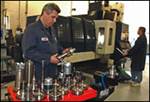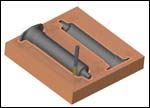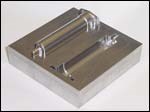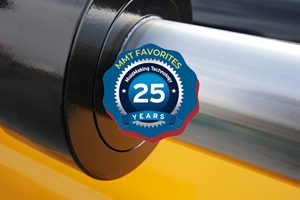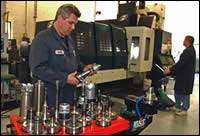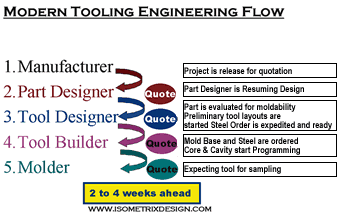How to Achieve Tool Shop Optimization
A five-step methodology to face your delivery, quality and cost challenges head on.
Delivery, quality and cost are the top three challenges facing tooling companies, according to a recent survey.1 A closer look into the causes helps to identify solutions to eliminate or minimize these pains.
A Common Pitfall: Jumping into a Solution without Process Analysis
In talking with tool shop executives, it became apparent that many do not take the time to analyze their business processes. Working in a highly competitive environment, firefighting has become the standard mode of operations at most shops. When faced with a challenge, the common reaction is to grab for the most immediate solution—be it purchasing a new machine, extending business hours, outsourcing, or adding a new, detached software solution. As a result, many of these solutions fail to address the root causes of the problem at hand.
More than 50 percent of tool shops polled in the survey indicated that their first priority is to implement advanced technology. Survey analysis2 revealed that many of these implementations have failed to solve the problems for which they were acquired. In one example, a tool shop has recently invested a significant amount of money to purchase additional machines for the purpose of expediting delivery times. While the investment helped speed up machining, it created new bottlenecks throughout the process and ultimately fell short of reducing overall delivery times.
Another tool shop that had trouble meeting delivery times began outsourcing their design work. While the outsourcing increased their cost, the need for greater communication between parties negated any improvement in delivery times.
Through the analysis it was revealed from tool shop executives that many investments in technology failed to deliver the expected results; hence, it’s clear that tool shops need more than better technology; they need someone to help them improve business processes.
Tool Shop Optimization
The starting point in any improvement is a clear understanding of the business goals. In the analysis process, a set of goals was discovered that has been close to universal across the companies interviewed: increase productivity, shorten delivery times, reduce costs, control engineering changes, and increase customer satisfaction as well as employee motivation.
The more difficult question was how to get there. To help tool shops with this undertaking, a five-step methodology was developed, which has since has been tested out and proven to produce positive results:
1. Identify the best process and flow.
All too often, companies invest in new technology or software, but oftentimes this merely moves bottlenecks from one area to another or creates other burdens in translation, as seen in the case study sidebar (see case study). The first step is to establish a streamlined process that covers all deliverables and milestones—from the initial price quote to the finished product. Inputs and outputs for each step in the process must be clearly identified, along with quality expectations and the value added to the finished product. Only once the entire process has been laid out can specific technologies and methods be considered for individual tasks; these would be evaluated based on their impact on the entire process, not just the task at hand.
2. Streamline internal and external communications.
Direct data transfer with the customer and among the design team, shop floor and purchasing not only saves time by minimizing the need for multiple data translations, it also increases data reliability, reduces errors and repeat work and minimizes engineering changes. To get started, minimize the use of printed documents, with the eventual goal of operating as a paperless company.
3. Implement 3-D design and manufacturing.
Striving toward concurrent processes, implementation of 3-D data minimizes downtime and eliminates the level of redundancy caused by caused by manually entering data into the machines, as is the case with 2-D design work.
4. Re-examine outsourcing.
Including your outsourced activities in your process design may reveal opportunities to bring work back in-house and reduce costs, eliminate communication obstacles, and speed up delivery times in order to be more competitive. If certain activities must be outsourced focus on improving the communication process with these partners and better integrating them into the overall process.
5. Implementation.
A solid implementation plan is the key to the success of the entire process. The implementation plan should consider all factors and constraints and include a contingency plan for unplanned events such as fluctuations in the shop’s workload. To shield customers from any negative impact during the implementation, maintaining and even improving delivery times throughout the transition should be a priority.
The optimization plan results in a more streamlined operational approach, usually with fewer steps in the toolmaking process. Resistance to change is natural, so getting all parties involved in the process early on is crucial to its success. The cost of change must also be acknowledged and quantified: What will be the loss of productivity during the initial implementation? When is it gained back? At what point does productivity surpass previous levels through the optimization?
Measuring success is an important part of the optimization process. Using this approach, enabled tool shops to achieve tangible and measurable results, with more than a 30 percent increase in productivity and up to a 50 percent design cost reduction.
Have You Evaluated Your Process?
The lessons are clear. The next time you think about improving your tool shop business performance, don’t start with the solution. Instead, first examine your entire process and figure out how to make it work better—from quoting to delivery.
References
1 Cited survey was conducted by CIMdata, a premier industry research firm.
2 Survey analysis conducted for moldmaking industry completed by Cimatron.
Related Content
How to Correctly Size a Hydraulic Cylinder
This week Randy shares steps for correctly sizing a hydraulic cylinder on a mold.
Read MoreMaintaining a Wire EDM Machine
To achieve the ultimate capability and level of productivity from your wire EDM on a consistent, repeatable and reliable basis, regular maintenance is a required task.
Read MoreLaser Welding Versus Micro Welding
The latest battle in finely detailed restoration/repair of mold materials.
Read MoreMold Design Review: The Complete Checklist
Gerardo (Jerry) Miranda III, former global tooling manager for Oakley sunglasses, reshares his complete mold design checklist, an essential part of the product time and cost-to-market process.
Read MoreRead Next
Transforming a Modeling Tool Into a Collaborative Environment
Simultaneous product development and manufacturing represents a breakthrough in design team interaction—streamlining mold design.
Read MoreThe Key to Up-Front Mold Design
By involving the tool designer, builder and molder early in product development, you can reduce turnaround time by weeks or even months, shave weeks off the mold construction cycle and reduce costs by eliminating potential product design troubles.
Read More
